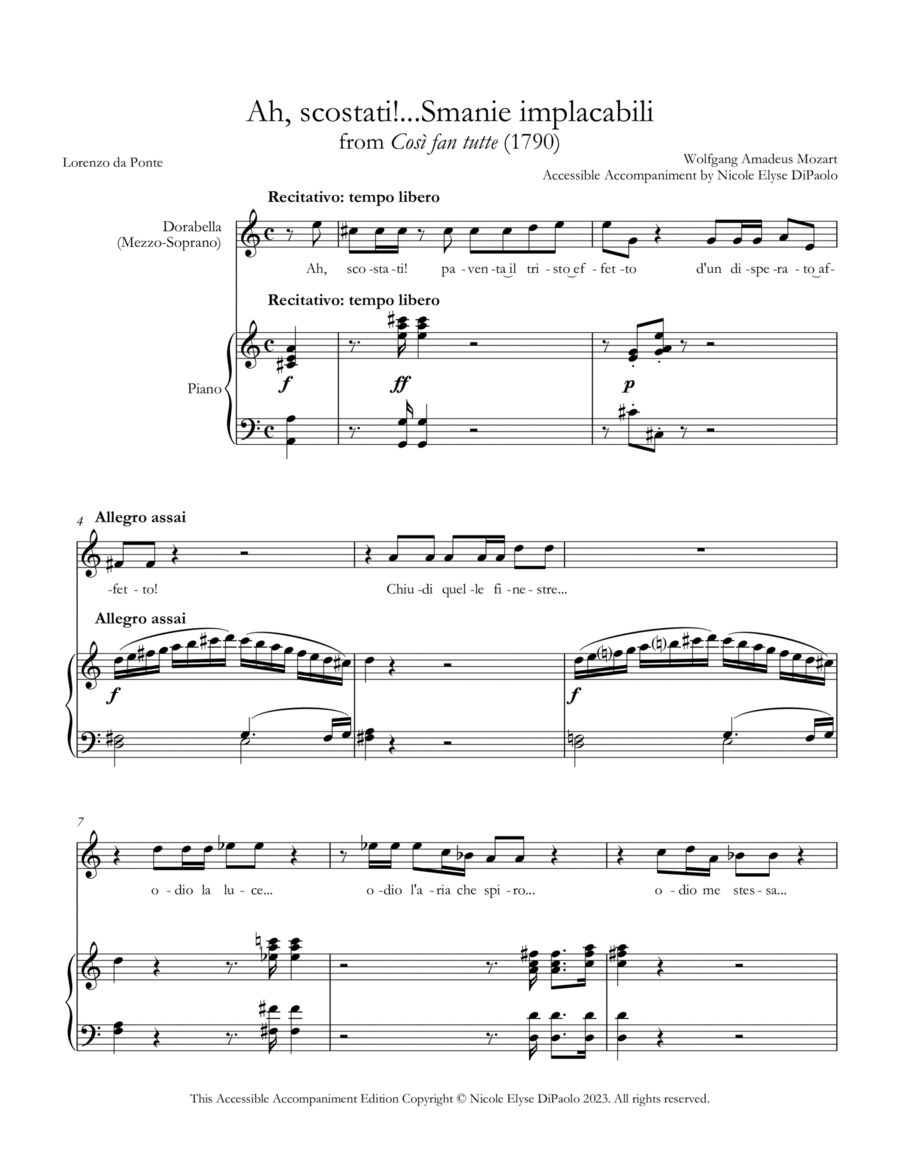Mezzo-Soprano Voice,Vocal Solo - Level 5 - Digital Download SKU: A0.1186002 Composed by Wolfgang Amadeus Mozart. Arranged by Nicole Elyse DiPaolo. Classical,Opera. 10 pages. Nicole Elyse DiPaolo #785660. Published by Nicole Elyse DiPaolo (A0.1186002). The first of its kind, this is a much more readable and sight-playable piano/vocal reduction of Ah, scostati!...Smanie implacabili,â Dorabellaâs first aria from Mozartâs Così fan tutte (1790). The sextuplets in the right hand found in most standard reductions have been condensed into triplets with a grace note, emphasizing that the gestural shape is what needs to be heard rather than every individual note, and the result is a much clearer and less note-filled score for the audition pianist. Some large spans in the left hand have also been reduced out and redistributed for more ergonomic playing on long audition days. When a grace note has an accidental that is then repeated later in the gesture, Iâve rewritten that accidental on the full-size note containing it for ease of reading (so the cue-size accidental is not the only indication of said accidental in the measure, which would make it too easy to miss). The recitative âAh, scostati!â is also included with slight alterations and courtesy accidentals in the melodic minor scales.As with any Accessible Accompaniments edition thatâs not also an audition/solo cut, I suggest bringing two copies to each audition: one Accessible Accompaniment and one copy of a standard edition. Audition pianists who donât know the aria will almost always choose the cleaner look of the Accessible Accompaniment, but those who know âSmanieâ well might prefer to play from the edition they learned it from. This will provide singers and their audition pianists every chance of a successful collaboration.All Accessible Accompaniments, including this one, boast several unique features:1. No reduction ever requires stretches of over an octave, not including bass notes meant to be held or âfudgedâ with the pedal (though octaves may also contain chord tones within them). This reduces the amount of rearranging that smaller-handed pianists must already do. Obviously, further reworkings are to be expected and pianists should feel free to add to or modify what Iâve provided.2. Iâve included less essential, but potentially desirable additional voices/passages in cue-size noteheads so that pianists can easily see them, but know that they are not necessary in a âsink or swimâ accompanying situation. Presenting less essential material in cue-size noteheads also reduces visual clutter on the page.3. In addition to the composerâs markings, when needed, I have included additional courtesy accidentals.4. All page turns have been carefully selected so as to result in the least possible disruption to the pianist when possible. 5. When known, Iâve noted alternate cuts that singers might like to take within certain arias.6. Iâve also replaced text âcresc.â and âdim.â markings with hairpins, which are easier to see in high-pressure sight-reading situations.About the Arranger:Praised as a sensitive pianist and outstanding accompanist who delivers powerful interpretations, Nicole Elyse DiPaolo enjoys a multifaceted career as a sought-after collaborative pianist, educational composer, arranger, coach, private teacher, and adjunct music professor. Currently based in the Cleveland area, Ms. DiPaolo has appeared as a concerto soloist with the Ambassador Chamber Players on multiple occasions and as a recitalist, collaborator, and presenter worldwide. Currently, Ms. DiPaolo is an online Adjunct Lecturer in Music at Indiana University; the Principal Theory Teacher at Liberty Park Music, an online-only video subscription-based music school; an invited blog contributor and guest instructor at Tonebase; and a sought-after online instructor of piano, music theory, and composition who includes partimento and historical improvisation in her curricula. For more information, please visit http://ndipaolo.musicaneo.com .
